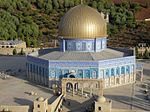This is an old revision of this page, as edited by Shuki (talk | contribs) at 22:31, 15 August 2010 (rv disruption). The present address (URL) is a permanent link to this revision, which may differ significantly from the current revision.
Revision as of 22:31, 15 August 2010 by Shuki (talk | contribs) (rv disruption)(diff) ← Previous revision | Latest revision (diff) | Newer revision → (diff)
 The Western Wall and Dome of the Rock at Mini Israel
The Western Wall and Dome of the Rock at Mini Israel
Mini Israel (Template:Lang-he) is a miniature park located near Latrun, Israel in the Ayalon Valley. Opened in November 2002, the site contains miniature replicas of hundreds of buildings and landmarks in Israel. The tourist attraction consists of about 350 miniature models on a scale of 1:25.
The permanent exhibition shows the main sites and structures in Israel that are of importance to Judaism, Christianity, and Islam. The sites are of historical, archeological, cultural, religious, and ethnic importance dipicting the sites and the ethnic groups associated with them, such as different Muslim cultural groups, Jewish, and Christians living in the country, but also Druze, Bedouin and others. The signs are in Hebrew, Arabic, and English. 95% of the visitors are Israeli.
The entire complex covers 60,000 square metres with the models displayed over 35,000 sq m. The park also includes a souvenir shop, a few restaurants and rest areas and a hall for lectures and meetings in which a film about the creation of the park is displayed. An audio guide and motorised buggies are available.
History


The slogan since its inception has been "See it all - small". The designers, architects and model builder team consisted of over 100 people from all parts of Israeli society and religions, including many new immigrants from the former USSR.
The park was the brainchild of Israeli entrepreneur Eiran Gazit who conceived the idea after visiting the famous miniature town of Madurodam in the Netherlands in 1986. Delayed by the First Intifada, Gazit began plans to build the park in 1994. The park was created by Gazit and his partners, Yoni Shapira serving as creative and marketing director, Mike Madeson in charge of international projects, and Koby Plashkes was the technical director. It was funded mainly by two large investing groups: Granite HaCarmel and Secom of the Shikun Ubinui Group. It cost $20 million USD, with 15% of the funding coming from the Israel Tourism Office. The park was built on land owned by Kibbutz Nachshon.
It had 350,000 visitors in its first nine months of opening.
The models
The park consists of about 350 buildings and landmarks, 30,000 figures, 500 animals, plants and 15,000 real trees, 4,700 cars, 100 motorbikes, 14 trains, 3 helicopters, 32 aircraft, 175 ships and 230 trucks. All trees are real bonsai cultivated and planted by the Agronoy nursery.
The park is loosely shaped like a star of David with each of the six triangles representing an area or city: Jerusalem; Tel Aviv; Haifa; Galil; Negev; Center. Models were created in workshops spread throughout Israel using sophisticated computerized evaluations, based on research prepared by Mini Israel staff.
Most of the buildings were built in the scale of 1:25. Exceptions represent:
- The Moshav of Nahalal - 1:250
- The Orot Rabin power station - 1:50
- The Walls of Jerusalem and Acre were reduced to 1:50 leaving their height at 1:25
- The Menorah in the forecourt of the Knesset - 1:15
All items are either made of polyurethane or similar polymeric materials or small stones. They were all painted with waterproof paint, so that the items would be resistant to weather conditions. Many of the models include kinetic moving parts such as trains, planes, a soccer game, heavy equipment, boats etc.
Analysis
The park has been criticised for mis-representing and depoliticising Israel. It avoids the issue of national borders and the Occupied Territories by presenting the site as a Star of David instead of as a map. Arab towns are not included, and only two sites in the West Bank are included. The Golan Heights and East Jerusalem are presented as being part of Israel.
References
- Walz, Steve (28 May 2010). "Israel: A Summer Like You've Never Experienced Before". The Jewish Journal of Greater Los Angeles. Retrieved 14 June 2010.
- ^ "Mini Israel". Haaretz. 25 March 2008. Retrieved 14 June 2010.
- ^ "Mini Israel". Jerusalem Post. 25 January 2010. Retrieved 14 June 2010.
- ^ Oestermann, Richard (2006). Every second counts: true stories from Israel. Gefen Publishing House Ltd. p. 123. ISBN 9652293598.
- ^ Veeder, Nechama (22 August 2003). "Homage to the holy land". Jerusalem Post. Retrieved 14 June 2010.
- Brauch, Julia; Lipphardt, Anna; Nocke, Alexandra (2008). Jewish topographies: visions of space, traditions of place. Ashgate Publishing, Ltd. p. 331. ISBN 0754671186.
External links
31°50′32.97″N 34°58′2.1″E / 31.8424917°N 34.967250°E / 31.8424917; 34.967250
Categories: